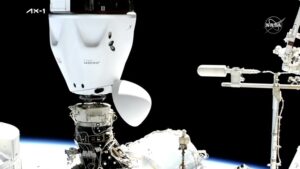UNH research tests fundamental force advancing understanding of universe
Wednesday, 02 November 2022 10:19 Research from a team of physicists at the University of New Hampshire is advancing the understanding of how protons, which comprise 95% of the mass of the visible universe, interact with each other. The results provide a benchmark for testing the strong force, one of the four fundamental forces in nature.
"There's a lot still unanswered about both of those things, the proton and the strong
Research from a team of physicists at the University of New Hampshire is advancing the understanding of how protons, which comprise 95% of the mass of the visible universe, interact with each other. The results provide a benchmark for testing the strong force, one of the four fundamental forces in nature.
"There's a lot still unanswered about both of those things, the proton and the strong DARPA awards Spire Global contract to design satellite
Wednesday, 02 November 2022 10:19 Spire Global, Inc. (NYSE: SPIR), a leading global provider of space-based data, analytics and space services, was awarded a contract by the Defense Advanced Research Projects Agency (DARPA) to deliver a preliminary design for a satellite that would carry an array of sensors to very low Earth orbit (VLEO) for in-situ ionosphere measurements.
The award is part of DARPA's Ouija program, which
Spire Global, Inc. (NYSE: SPIR), a leading global provider of space-based data, analytics and space services, was awarded a contract by the Defense Advanced Research Projects Agency (DARPA) to deliver a preliminary design for a satellite that would carry an array of sensors to very low Earth orbit (VLEO) for in-situ ionosphere measurements.
The award is part of DARPA's Ouija program, which New lab module to assist space station's completion
Wednesday, 02 November 2022 10:19 China's Mengtian space lab module, the third major component of the nation's Tiangong space station, was launched on Monday afternoon in a key step to complete the in-orbit assembly of Tiangong.
The lab module's carrier - a Long March 5B heavy-lift rocket - blasted off at 3:37 pm from the Wenchang Space Launch Center in the southernmost island province of Hainan.
After flying more th
China's Mengtian space lab module, the third major component of the nation's Tiangong space station, was launched on Monday afternoon in a key step to complete the in-orbit assembly of Tiangong.
The lab module's carrier - a Long March 5B heavy-lift rocket - blasted off at 3:37 pm from the Wenchang Space Launch Center in the southernmost island province of Hainan.
After flying more th SpaceX launches Falcon Heavy rocket for first time in three years
Wednesday, 02 November 2022 10:19 SpaceX launched its Falcon Heavy rocket from Florida Tuesday, the first flight since 2019 of the world's most powerful rocket.
Mission USSF-44, transporting cargo for the US Space Force, including the TETRA 1 satellite, blasted off from the Kennedy Space Center around 9:40 am (1340 GMT).
Several minutes later, the rocket's two side boosters made their way back to Earth - the craft's m
SpaceX launched its Falcon Heavy rocket from Florida Tuesday, the first flight since 2019 of the world's most powerful rocket.
Mission USSF-44, transporting cargo for the US Space Force, including the TETRA 1 satellite, blasted off from the Kennedy Space Center around 9:40 am (1340 GMT).
Several minutes later, the rocket's two side boosters made their way back to Earth - the craft's m How scientist developed an intelligent fuzzy logical control to stabilize solar sail?
Wednesday, 02 November 2022 10:19 Solar sail, a form of longevous spacecraft without propellant demand, attracts numerous aerospace researchers' attention. Its prolongable peculiarity enables its tremendous potential in diverse interplanetary missions. Due to the harsh space environment, it is inevitable that the spacecraft with long time on-orbit suffers the performance degradation and accident. Especially, the force model will
Solar sail, a form of longevous spacecraft without propellant demand, attracts numerous aerospace researchers' attention. Its prolongable peculiarity enables its tremendous potential in diverse interplanetary missions. Due to the harsh space environment, it is inevitable that the spacecraft with long time on-orbit suffers the performance degradation and accident. Especially, the force model will Sidus Space engages Dawn Aerospace to implement propulsion technology into LizzieSat
Wednesday, 02 November 2022 10:19 Sidus Space, Inc. (NASDAQ:SIDU), a Space-as-a-Service company focused on mission critical hardware manufacturing combined with commercial satellite design, manufacture, launch, and data collection, announced agreement with Dawn Aerospace ("Dawn") to implement its green, chemical propulsion technology into LizzieSat.
Among the novel characteristics of Sidus Space's proprietary LizzieSat is
Sidus Space, Inc. (NASDAQ:SIDU), a Space-as-a-Service company focused on mission critical hardware manufacturing combined with commercial satellite design, manufacture, launch, and data collection, announced agreement with Dawn Aerospace ("Dawn") to implement its green, chemical propulsion technology into LizzieSat.
Among the novel characteristics of Sidus Space's proprietary LizzieSat is China's 'Palace in the sky' space station complete after successful launch
Wednesday, 02 November 2022 10:19 China successfully launched the third and final module needed to complete the Tiangong Space Station.
The Chinese National Space Administration announced its Mengtian module arrived in low Earth orbit after a 13-hour voyage. Mengtian was carried to orbit by a Long March 5B, which was designed specifically to launch the Tiangong modules into space.
Mengtian, which translates to "Dream
China successfully launched the third and final module needed to complete the Tiangong Space Station.
The Chinese National Space Administration announced its Mengtian module arrived in low Earth orbit after a 13-hour voyage. Mengtian was carried to orbit by a Long March 5B, which was designed specifically to launch the Tiangong modules into space.
Mengtian, which translates to "Dream AIR lofts heavy payload balloon into near-space height
Wednesday, 02 November 2022 10:19 A high-altitude scientific balloon containing 1.2-ton payloads was lifted into the sky and reached an altitude of 30km in a demonstration test that helped validate the payload capacity of a near-space balloon platform.
The flight test was conducted in northwestern China's Qinghai Province on September 30, 2022 by a research team from the Aerospace Information Research Institute (AIR), Chin
A high-altitude scientific balloon containing 1.2-ton payloads was lifted into the sky and reached an altitude of 30km in a demonstration test that helped validate the payload capacity of a near-space balloon platform.
The flight test was conducted in northwestern China's Qinghai Province on September 30, 2022 by a research team from the Aerospace Information Research Institute (AIR), Chin Meteorite impacts on the surface of Mars provide new details of the planet's crust
Wednesday, 02 November 2022 10:19 Data from two meteorite impacts on Mars recorded by NASA's InSight spacecraft provide new insights into the structure of the Martian crust. Previously, researchers had observed many quakes whose waves spread from the epicentre of a quake through the interior of the planet. Since then, they had been hoping for an event that would also generate waves traveling along the planet's surface.
On
Data from two meteorite impacts on Mars recorded by NASA's InSight spacecraft provide new insights into the structure of the Martian crust. Previously, researchers had observed many quakes whose waves spread from the epicentre of a quake through the interior of the planet. Since then, they had been hoping for an event that would also generate waves traveling along the planet's surface.
On CAPSTONE completes successful maneuver, teeing up Lunar orbit
Wednesday, 02 November 2022 10:19 The CAPSTONE spacecraft successfully completed a trajectory correction maneuver on Thursday, Oct. 27, teeing up the spacecraft's arrival to lunar orbit on Nov. 13.
CAPSTONE is no longer in safe mode following an issue in early September that caused the spacecraft to spin. The team identified the most likely cause as a valve-related issue in one of the spacecraft's eight thrusters.
Th
The CAPSTONE spacecraft successfully completed a trajectory correction maneuver on Thursday, Oct. 27, teeing up the spacecraft's arrival to lunar orbit on Nov. 13.
CAPSTONE is no longer in safe mode following an issue in early September that caused the spacecraft to spin. The team identified the most likely cause as a valve-related issue in one of the spacecraft's eight thrusters.
Th Ignite your potential! Apply now to the ESA Student Internship Programme
Wednesday, 02 November 2022 09:00
The 2023 internship opportunities at ESA have been published! Opportunities are open for one month and positions are available in engineering, science, IT, natural/social sciences, business and administration services. This is your chance to kick-off your experience in space!
Space for the future: green steel, sweet air, happy plants
Wednesday, 02 November 2022 07:21
For decades, satellites have been instrumental in monitoring our changing climate and improving our understanding of the processes that drive it. But to achieve our climate goals and make Europe the first climate-neutral continent by 2050, we need ideas that take the next step and begin to use space technologies to actively prevent, slow, reverse or otherwise address these changes.
Orbex to build Scottish launch site
Tuesday, 01 November 2022 22:00
Small launch vehicle developer Orbex announced Nov. 1 it had secured agreements to begin construction of a launch site in northern Scotland for its rocket that will allow a first launch by the end of 2023.
The post Orbex to build Scottish launch site appeared first on SpaceNews.
Saudi astronauts to fly on Ax-2 mission to ISS
Tuesday, 01 November 2022 20:45
NASA confirmed Nov. 1 that two astronauts from Saudi Arabia will go to the International Space Station on a private mission in the spring of 2023 operated by Axiom Space.
The post Saudi astronauts to fly on Ax-2 mission to ISS appeared first on SpaceNews.
Spire selected to design satellite for DARPA experiment in very low orbit
Tuesday, 01 November 2022 18:45
DARPA selected Spire Global to design a small satellite for an experiment to study high-frequency radio signals in the upper layers of the atmosphere.
The post Spire selected to design satellite for DARPA experiment in very low orbit appeared first on SpaceNews.

